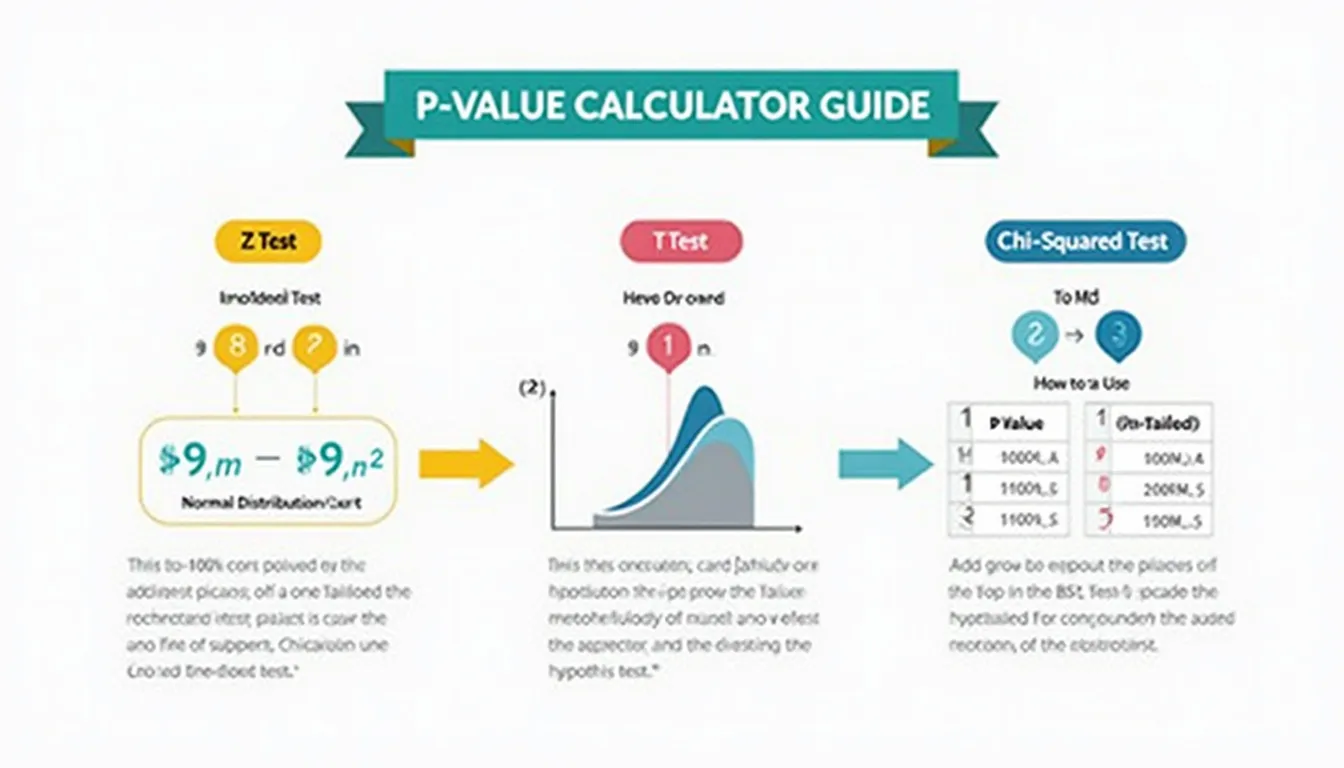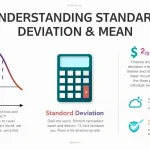P-Value Calculator
Is this tool helpful?
How to Use the P-Value Calculator Effectively
This versatile P-Value Calculator simplifies statistical hypothesis testing for users of all levels. Follow these straightforward steps to obtain accurate p-values for your data analysis:
-
Select the Statistical Test: Pick the appropriate test for your data and research needs:
- Z-test: Ideal for comparing a sample mean to a known population mean when population standard deviation is known.
- t-test: Suitable for estimating differences when population standard deviation is unknown and estimated from sample data.
- Chi-squared test: Used for categorical data to compare observed and expected frequencies.
-
Fill in the Required Inputs: Enter numerical values based on your selected test. For example:
- Z-test: Sample Mean (e.g., 65.4), Population Mean (e.g., 70.2), Population Standard Deviation (e.g., 9.5), Sample Size (e.g., 40)
- t-test: Sample Mean (e.g., 22.3), Population Mean (e.g., 20.0), Sample Standard Deviation (e.g., 3.8), Sample Size (e.g., 18)
- Chi-squared test: Observed Frequencies (e.g., 15,23,37) and Expected Frequencies (e.g., 20,20,35)
- Set the Significance Level (α): Input your desired confidence threshold, typically 0.05 for 95% confidence. You may also use 0.01 or 0.10 depending on your study’s requirements.
- Choose the Tail Type: Determine whether your hypothesis is two-tailed (testing for any difference) or one-tailed (testing directionally).
- Calculate the P-value: Click the “Calculate P-value” button to process your inputs. The tool computes the test statistic and returns the p-value instantly.
- Interpret the Results: Review the displayed p-value, test statistic, degrees of freedom (if applicable), and the decision to either reject or fail to reject the null hypothesis based on your input significance level.
Introducing the P-Value Calculator: Your Statistical Hypothesis Testing Companion
The P-Value Calculator is a user-friendly online tool designed to streamline statistical hypothesis testing with precision and ease. Whether you’re a student, researcher, or professional working with data, this calculator helps you quickly determine the statistical significance of your findings from commonly used tests like the Z-test, t-test, and Chi-squared test.
By automating complex calculations, it empowers users to make well-informed conclusions efficiently without needing deep statistical software knowledge. The calculator’s intuitive interface allows you to input your sample data, specify test parameters, and instantly receive comprehensive results including the p-value, which quantifies the probability of observing results as extreme as your data assuming the null hypothesis is true.
Key Benefits of Using the P-Value Calculator
- Time-Saving Automation: Quickly performs complex hypothesis testing calculations, eliminating the need for manual computations.
- Supports Multiple Tests: Conveniently switch between Z-test, t-test, and Chi-squared test within one tool tailored for different data types.
- Accurate & Reliable: Utilizes trusted statistical algorithms ensuring precise p-value computation for dependable results.
- Flexible Significance Levels: Customize your α value to match study design preferences or academic requirements.
- Enhanced Learning Value: Offers immediate feedback for educational purposes by displaying test statistics and critical decision measures.
Example Calculations Using the P-Value Calculator
Example 1: Z-Test Calculation
Suppose a nutritionist wants to determine if the average sodium content in a new brand of canned soup differs from the established mean sodium level of 140 mg.
- Sample Mean (X̄) = 135 mg
- Population Mean (μ₀) = 140 mg
- Population Standard Deviation (σ) = 12 mg
- Sample Size (n) = 49
Using the Z-test formula:
$$ Z = \frac{\bar{X} – \mu_0}{\sigma / \sqrt{n}} $$
Calculating:
$$ Z = \frac{135 – 140}{12 / \sqrt{49}} = \frac{-5}{12 / 7} = \frac{-5}{1.714} \approx -2.917 $$
For a two-tailed test with α = 0.05, the calculator obtains a p-value:
$$ \text{P-value} = 2 \times (1 – \Phi(|-2.917|)) \approx 0.0035 $$
The calculator results would indicate:
- P-value: 0.0035
- Test Statistic: -2.917
- Decision: Reject the null hypothesis
This outcome provides strong evidence that the new soup’s average sodium content significantly differs from 140 mg.
Example 2: t-Test Calculation
Imagine a psychologist assessing whether a new teaching strategy changes students’ average test scores compared to a known standard mean of 75.
- Sample Mean (X̄) = 78
- Population Mean (μ₀) = 75
- Sample Standard Deviation (s) = 5
- Sample Size (n) = 20
Calculating the t-statistic:
$$ t = \frac{\bar{X} – \mu_0}{s / \sqrt{n}} = \frac{78 – 75}{5 / \sqrt{20}} = \frac{3}{1.118} \approx 2.684 $$
The degrees of freedom (df) are:
$$ df = n – 1 = 19 $$
For a one-tailed test with α = 0.05, the corresponding p-value can be quickly found using the calculator.
Example 3: Chi-Squared Test Calculation
A marketer wants to check if observed customer preferences match the expected distribution across three product categories.
- Observed Frequencies: 40, 35, 25
- Expected Frequencies: 30, 40, 30
The chi-squared statistic is calculated as:
$$ \chi^2 = \sum \frac{(O_i – E_i)^2}{E_i} = \frac{(40-30)^2}{30} + \frac{(35-40)^2}{40} + \frac{(25-30)^2}{30} = 3.33 + 0.625 + 0.833 = 4.79 $$
With degrees of freedom:
$$ df = k – 1 = 3 – 1 = 2 $$
The calculator quickly computes the p-value and helps determine whether to reject the null hypothesis of equal distribution.
Why Choose This Online P-Value Calculator for Statistical Significance Testing?
User-Friendly Interface with Tailored Inputs
The calculator’s clean form dynamically adjusts input fields depending on the test selected. This ensures users only see and fill relevant parameters, reducing confusion and enhancing the user experience.
Robust Support for Diverse Research Needs
Whether you’re analyzing sample means with known or unknown population variances or comparing categorical distributions, this calculator accommodates a wide range of statistical scenarios supporting diverse research projects.
Instant and Accurate Statistical Results
Grounded in reliable statistical libraries and JavaScript algorithms, the calculator effortlessly delivers accurate p-values and related statistics, facilitating quick decision-making without software installation.
Perfect for Educational and Professional Use
From students needing to verify homework problems to professionals conducting rigorous data analysis, this tool bridges the gap by combining sophistication with simplicity.
Customizable Significance Levels and Tail Types
Adjustable α thresholds and tail types let you tailor hypothesis testing criteria according to your specific research design, regulatory standards, or field conventions, enhancing flexibility in reporting and interpretation.
Important Disclaimer
The calculations, results, and content provided by our tools are not guaranteed to be accurate, complete, or reliable. Users are responsible for verifying and interpreting the results. Our content and tools may contain errors, biases, or inconsistencies. We reserve the right to save inputs and outputs from our tools for the purposes of error debugging, bias identification, and performance improvement. External companies providing AI models used in our tools may also save and process data in accordance with their own policies. By using our tools, you consent to this data collection and processing. We reserve the right to limit the usage of our tools based on current usability factors. By using our tools, you acknowledge that you have read, understood, and agreed to this disclaimer. You accept the inherent risks and limitations associated with the use of our tools and services.







